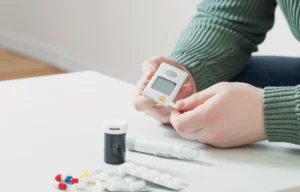What is diabetic foot care? Diabetic foot care is important for managing diabetes and preventing severe complications. In this blog, Understanding the importance of foot care and following proper steps can significantly improve the quality of life for diabetic patients.
The importance of diabetic foot care

Diabetic foot care is a crucial aspect of handling diabetes, requiring regular preservation and vigilant monitoring to save you from intense complications. Diabetics are at a higher risk for foot problems because of bad blood circulation and nerve harm,
situations referred to as peripheral arterial disorder (PAD) and diabetic neuropathy, respectively. These complications can cause intense outcomes if not addressed promptly.
Regular foot care involves several key practices
Daily inspections are important for identifying any changes or abnormalities in the feet, such as cuts, blisters, redness, or swelling. By catching these issues early, patients can seek timely medical intervention, preventing minor problems from escalating into serious infections or ulcers.
Proper hygiene is another critical component, involving daily washing with lukewarm water, thorough drying, especially between the toes, and moisturizing to prevent dryness and cracking.
Wearing appropriate footwear is important
Diabetics should choose well-fitted, supportive shoes that protect their feet from injuries and reduce pressure points. The use of ill-fitting shoes or going barefoot may cause blisters, sores, and other complications that may develop into ulcers.
Regular nail care is also important to prevent ingrown toenails and infections; nails should be trimmed straight across and filed to avoid sharp edges.
Proper diabetic foot care also includes maintaining optimal blood sugar levels. High blood sugar can damage nerves and blood vessels, exacerbating foot problems. Therefore, controlling blood glucose levels is fundamental to preventing complications.
By following these guidelines, diabetics can significantly reduce the risk of serious complications such as infections, ulcers, and even amputations. Early detection and treatment of issues with regular foot care help ensure better overall health and quality of life for diabetic patients.
Diabetics Should Take Care of Their Feet?

Diabetics are prone to foot problems due to poor blood circulation and nerve damage. Regular foot care can prevent minor issues from becoming severe, ensuring overall health and mobility.
Key Components
- Daily Inspections: Check feet daily for cuts, blisters, redness, or swelling. Early detection is crucial.
- Proper Footwear: Wear well-fitted shoes that protect and cushion feet. Avoid walking barefoot.
- Hygiene: Wash feet daily with lukewarm water, dry thoroughly, and moisturize to prevent dryness and cracking.
- Nail Care: Trim nails straight across and file edges to avoid ingrown nails.
- Blood Sugar Control: Maintain optimal blood sugar levels to prevent nerve damage and circulation issues.
Steps of Diabetic Foot Care

Daily Checks: Daily inspections are the basis of diabetic foot care. Each day, take some moments to thoroughly look at your feet for any modifications or accidents. Look for cuts, blisters, redness, swelling, or any other abnormalities.
Using a replicate allows you to see the bottoms of your toes, and remember to test among your feet. Early detection of any troubles can prevent minor issues from turning into severe complications, which include infections or ulcers.
Hygiene Routine: Maintaining proper foot hygiene is important for preventing infections and keeping your toes healthy. Wash your toes each day with lukewarm water and a little cleaning soap. Avoid soaking your feet, as this could cause dryness.
After washing, dry your toes thoroughly, specifically among the toes, to save you from fungal infections. Apply a moisturizer to keep the pores and skin tender and hydrated, however, avoid using lotion between the feet, as excessive moisture can result in fungal growth.
Proper Footwear: Choosing the proper shoes is important for protecting your feet. Wear footwear that is healthy properly and offers sufficient guidance and cushioning. Avoid tight shoes, excessive heels, or footwear with narrow toe boxes, as they can cause blisters, sores, and other injuries.
Socks have to be soft and not too tight, preferably crafted from breathable materials to help manipulate moisture. Always keep away from barefoot, even at home, to prevent accidents.
Regular Doctor Visits: Regular check-ups with a diabetic foot care physician are essential for monitoring foot health. Schedule visits with a CCD healthcare provider, who can perform complete foot tests and become aware of capability problems before they become excessive.
Your medical doctor can provide personalized advice and treatment plans according to your specific desires, making sure that your feet remain in the first-class viable
Recognizing When to See a Doctor

- Persistent Sores or Ulcers: Seek medical attention if wounds do not heal.
- Infections: Look out for signs of infection like redness, swelling, or discharge.
- Numbness or Tingling: Report any unusual sensations to your doctor.
- Changes in Skin Color: Pigmentation can indicate poor circulation.
How CCD Helps Manage Diabetic Foot Care

The Collaborative Care of Diabetes (CCD) employs complete approaches to diabetic foot care. At CCD, patients benefit from:
- Specialized Services: Access to podiatrists and foot care specialists.
- Advanced Technologies: Use of the latest tools for early detection and treatment.
- Education Programs: Providing diabetic foot care education to empower patients.
Conclusion
What is Diabetic foot care? It is important to manage diabetes and stop critical pain. By following the right foot care steps and looking for proper medical care, patients can keep healthy feet and improve their first-class existence.
The Collaborative Care of Diabetes (CCD) gives specialized care and support to help diabetics control their foot health correctly.
FAQ’s
What is the first step in diabetic foot care?
The first step in diabetic foot care is a daily inspection to identify any potential issues early.
Why is proper footwear important for diabetics?
Proper footwear helps prevent injuries, reduces pressure on the feet, and avoids complications like ulcers.
How often should diabetics see a foot care doctor?
Diabetics should schedule regular check-ups with a foot care doctor, typically every few months, or as recommended.












